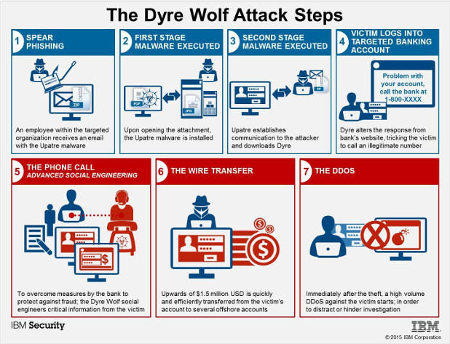Have any question?
Text or Call (954) 573-1300
Text or Call (954) 573-1300
 With the critically-acclaimed television series, Game of Thrones returning to viewers this spring, it seems apt to discuss a manner of hacking attack called Dyre Wolf. This particular threat is just as fierce as its name implies, and can potentially cost businesses between $500,000 to $1.5 million per attack. It takes advantage of a multi-step phishing process, and your employees should understand how to avoid attacks like these.
With the critically-acclaimed television series, Game of Thrones returning to viewers this spring, it seems apt to discuss a manner of hacking attack called Dyre Wolf. This particular threat is just as fierce as its name implies, and can potentially cost businesses between $500,000 to $1.5 million per attack. It takes advantage of a multi-step phishing process, and your employees should understand how to avoid attacks like these.
The vulnerability was discovered last October, but John Kuhn, a senior threat researcher for IBM, reports that Dyre is following the recent trend of moving toward more sophisticated hacking measures. According to ZDNet, this threat takes advantage of the Dyre banking trojan to infiltrate infrastructures and make off with a hefty chunk of change. They accomplish this by taking advantage of social engineering tactics designed to dupe users into revealing important information about accounts.
Unlike other Trojans that go after individual bank accounts, Dyre Wolf is designed to tackle large organizations that accrue a lot of profits. This is why it’s important to train your team to identify and manage a phishing attack without falling victim to these social engineering threats. Dyre Wolf uses a seven-step process to pull off these expensive hacks:

Of course, at the heart of any social engineering hack, the root of the problem comes from employees not understanding how to respond to potential threats. Social engineering thrives off of the average employee not knowing how to counter it; therefore, the best way to take the fight to this new generation of sophisticated hackers is to ingrain best practices into the minds of your workers.
To this end, IBM suggests the following procedures:
These are just a few ways to handle phishing and social engineering scams. For more information on how you can protect your business from these kind of hacks, give L7 Solutions a call at (954) 573-1300.
Learn more about what L7 Solutions can do for your business.
L7 Solutions
7890 Peters Road Building G102,
Plantation, Florida 33324
Comments